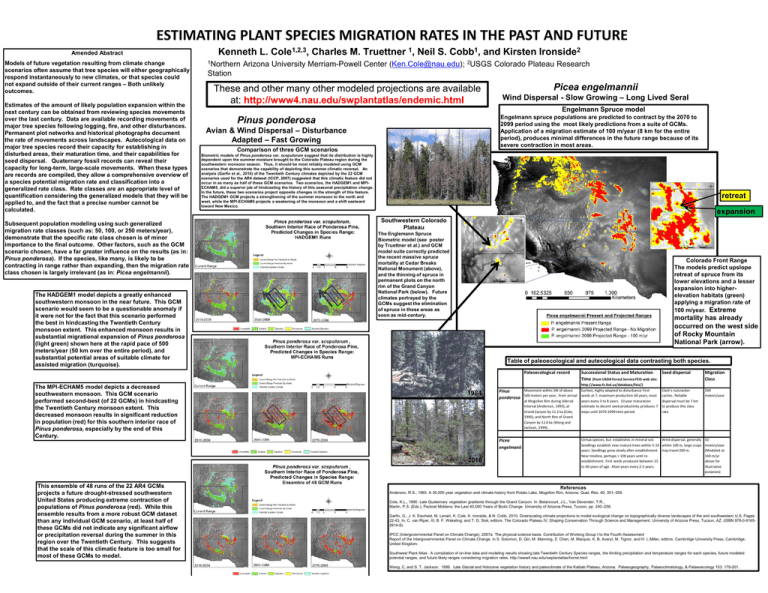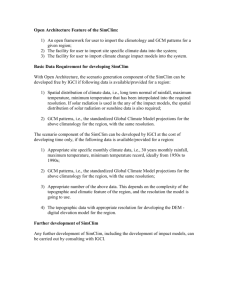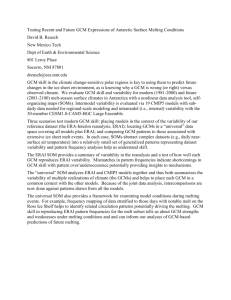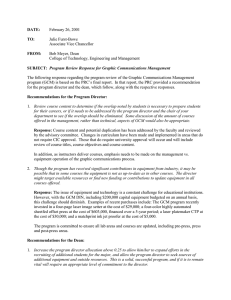ESTIMATING PLANT SPECIES MIGRATION RATES IN THE PAST AND FUTURE
advertisement

ESTIMATING PLANT SPECIES MIGRATION RATES IN THE PAST AND FUTURE Amended Abstract Models of future vegetation resulting from climate change scenarios often assume that tree species will either geographically respond instantaneously to new climates, or that species could not expand outside of their current ranges – Both unlikely outcomes. Estimates of the amount of likely population expansion within the next century can be obtained from reviewing species movements over the last century. Data are available recording movements of major tree species following logging, fire, and other disturbances. Permanent plot networks and historical photographs document the rate of movements across landscapes. Autecological data on major tree species record their capacity for establishing in disturbed areas, their maturation time, and their capabilities for seed dispersal. Quaternary fossil records can reveal their capacity for long-term, large-scale movements. When these types are records are compiled, they allow a comprehensive overview of a species potential migration rate and classification into a generalized rate class. Rate classes are an appropriate level of quantification considering the generalized models that they will be applied to, and the fact that a precise number cannot be calculated. Subsequent population modeling using such generalized migration rate classes (such as: 50, 100, or 250 meters/year), demonstrate that the specific rate class chosen is of minor importance to the final outcome. Other factors, such as the GCM scenario chosen, have a far greater influence on the results (as in: Pinus ponderosa). If the species, like many, is likely to be contracting in range rather than expanding, then the migration rate class chosen is largely irrelevant (as in: Picea engelmannii). The HADGEM1 model depicts a greatly enhanced southwestern monsoon in the near future. This GCM scenario would seem to be a questionable anomaly if it were not for the fact that this scenario performed the best in hindcasting the Twentieth Century monsoon extent. This enhanced monsoon results in substantial migrational expansion of Pinus ponderosa (light green) shown here at the rapid pace of 500 meters/year (50 km over the entire period), and substantial potential areas of suitable climate for assisted migration (turquoise). Kenneth L. Cole1,2,3, Charles M. Truettner 1, Neil S. Cobb1, and Kirsten Ironside2 1Northern Arizona University Merriam-Powell Center (Ken.Cole@nau.edu); 2USGS Colorado Plateau Research Station These and other many other modeled projections are available at: http://www4.nau.edu/swplantatlas/endemic.html Picea engelmannii Wind Dispersal - Slow Growing – Long Lived Seral Engelmann Spruce model Engelmann spruce populations are predicted to contract by the 2070 to 2099 period using the most likely predictions from a suite of GCMs. Application of a migration estimate of 100 m/year (8 km for the entire period), produces minimal differences in the future range because of its severe contraction in most areas. Pinus ponderosa Avian & Wind Dispersal – Disturbance Adapted – Fast Growing Comparison of three GCM scenarios Biometric models of Pinus ponderosa var. scopulorum suggest that its distribution is highly dependent upon the summer moisture brought to the Colorado Plateau region during the southwestern monsoon season. Thus, it should be most reliably modeled using GCM scenarios that demonstrate the capability of depicting this summer climatic reversal. An analysis (Garfin et al., 2010) of the Twentieth Century climates depicted by the 22 GCM scenarios used for the AR4 dataset (ICCP, 2007) suggested that this climatic feature did not occur in as many as half of these GCM scenarios. Two scenarios, the HADGEM1 and MPIECHAM5, did a superior job of hindcasting the history of this seasonal precipitation change. In the future, these two scenarios project opposite changes in the strength of this feature. The HADGEM1 GCM projects a strengthening of the summer monsoon to the north and west, while the MPI-ECHAM5 projects a weakening of the monsoon and a shift eastward toward New Mexico. retreat expansion Southwestern Colorado Plateau The Englemann Spruce Biometric model (see poster by Truettner et al.) and GCM model suite correctly predicted the recent massive spruce mortality at Cedar Breaks National Monument (above), and the thinning of spruce in permanent plots on the north rim of the Grand Canyon National Park (below). Future climates portrayed by the GCMs suggest the elimination of spruce in these areas as soon as mid-century. Southwestern Colorado Plateau The Englemann Spruce Biometric model (see poster by Truettner et al.) and GCM model suite correctly predicted the recent massive spruce mortality at Cedar Breaks National Monument (above), and the thinning of spruce in permanent plots on the north rim of the Grand Canyon National Park (below). Future climates portrayed by the GCMs suggest the elimination of spruce in these areas as soon as mid-century. This ensemble of 48 runs of the 22 AR4 GCMs projects a future drought-stressed southwestern United States producing extreme contraction of populations of Pinus ponderosa (red). While this ensemble results from a more robust GCM dataset than any individual GCM scenario, at least half of these GCMs did not indicate any significant airflow or precipitation reversal during the summer in this region over the Twentieth Century. This suggests that the scale of this climatic feature is too small for most of these GCMs to model. mortality has already occurred on the west side of Rocky Mountain National Park (arrow). Table of paleoecological and autecological data contrasting both species. Paleoecological record The MPI-ECHAM5 model depicts a decreased southwestern monsoon. This GCM scenario performed second-best (of 22 GCMs) in hindcasting the Twentieth Century monsoon extent. This decreased monsoon results in significant reduction in population (red) for this southern interior race of Pinus ponderosa, especially by the end of this Century. Colorado Front Range The models predict upslope retreat of spruce from its lower elevations and a lesser expansion into higherelevation habitats (green) applying a migration rate of 100 m/year. Extreme Pinus ponderosa Picea engelmanii Successional Status and Maturation Seed dispersal Time (from USDA Forest Service FEIS web site: http://www.fs.fed.us/database/feis/) Earliest, highly adapted to disturbance First Movement within SW of about 500 meters per year, from arrival seeds at 7, maximum production 60 years, mast years every 3 to 8 years. 10 year maturation at Mogollon Rim during Allerod Interval (Anderson, 1993), at estimate to decent seed productivity produces 7 Grand Canyon by 11.2 ka (Cole, steps until 2070‐2099 time period. 1990), and North Rim of Grand Canyon by 11.0 ka (Weng and Jackson, 1999). Clark’s nutcracker caches. Reliable dispersal must be 7 km to produce this class rate. Migration Class 500 meters/year Wind dispersal, generally 50 Climax species, but establishes in mineral soil. Seedlings establish near mature trees within 5‐10 within 100 m, large crops meters/year (Modeled at years. Seedlings grow slowly after establishment. may travel 200 m. 100 m/yr Near treeline, perhaps > 100 years until re‐ above for establishment. First seeds produced between 15 illustrative to 40 years of age. Mast years every 2‐5 years. purposes) References Anderson, R.S., 1993. A 35,000 year vegetation and climate history from Potato Lake, Mogollon Rim, Arizona. Quat. Res. 40, 351–359. Cole, K.L., 1990. Late Quaternary vegetation gradients through the Grand Canyon. In: Betancourt, J.L., Van Devender, T.R., Martin, P.S. (Eds.), Packrat Middens: the Last 40,000 Years of Biotic Change. University of Arizona Press, Tucson, pp. 240–258. Garfin, G., J. K. Eischeid, M. Lenart, K. Cole, K. Ironside, & N. Cobb. 2010. Downscaling climate projections to model ecological change on topographically diverse landscapes of the arid southwestern U.S. Pages 22-43, In, C. van Riper, III, B. F. Wakeling; and T. D. Sisk, editors. The Colorado Plateau IV; Shaping Conservation Through Science and Management. University of Arizona Press, Tucson, AZ. (ISBN 978-0-81652914-8). IPCC (Intergovernmental Panel on Climate Change). 2007a. The physical science basis. Contribution of Working Group I to the Fourth Assessment Report of the Intergovernmental Panel on Climate Change. in S. Solomon, D. Qin, M. Manning, Z. Chen, M. Marquis, K. B. Averyt, M. Tignor, and H. L.Miller, editors. Cambridge University Press, Cambridge, United Kingdom. Southwest Plant Atlas. A compilation of on-line data and modeling results showing late Twentieth Century Species ranges, the limiting precipitation and temperature ranges for each species, future modeled potential ranges, and future likely ranges considering migration rates. http://www4.nau.edu/swplantatlas/home.html Weng, C, and S. T. Jackson. 1999. Late Glacial and Holocene vegetation history and paleoclimate of the Kaibab Plateau, Arizona. Palaeogeography, Palaeoclimatology, & Palaeoecology 153: 179-201.






